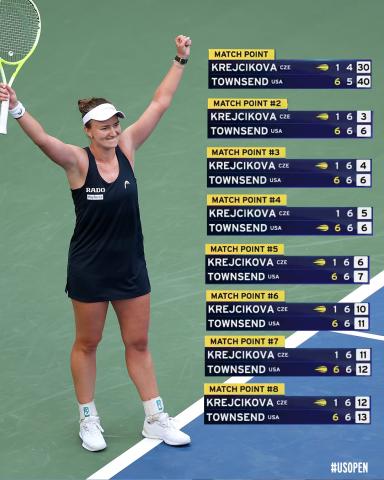
The US Open is often a theater of power, a cacophony of roaring crowds and thunderous serves. But in 2025, it was the site of a different masterpiece—one painted not with brute force, but with patience, strategy, and an unbreakable will. Barbora Krejcikova’s stunning victory run was more than just a tennis triumph; it was a seven-match clinic on the secret synergy of mind and body, a story of resilience that captivated the world.
The Secret: Forging the Winning Mind and Body Connection
Krejcikova’s success is never accidental. It’s the product of a meticulous philosophy where the mental and physical are inextricably linked.
-
The Body as an Instrument: Her game isn't built on overwhelming power but on precision, timing, and incredible variety. Her training focuses on footwork and core strength, allowing her to glide into the perfect position to unleash her technically flawless groundstrokes. For her, fitness isn't about hitting harder; it's about hitting smarter, longer, and with unerring consistency deep into a third set.
-
The Mind as the Conductor: This is where the true secret lies. Krejcikova treats a tennis match like a chess match. Every shot is a move, every change of pace a strategy. Her mental strength is her ability to stay locked in this problem-solving mode, never getting frustrated by an opponent's hot streak, but instead devising a new plan to break their rhythm.
The Weapon They Couldn't See: The Power of Visualization
Long before she stepped onto the asphalt of Arthur Ashe Stadium, Krejcikova had already won this tournament—in her mind.
"I visualize everything," she has often said. This isn't just a pre-match routine; it's a daily practice. She doesn't just see herself holding the trophy; she immerses herself in the sensory details:
-
She feels the pressure of a break point down.
-
She hears the roar of the crowd willing her opponent on.
-
She visualizes the specific patterns: the sharp angle of a backhand slice, the precise toss on a second serve under pressure, the feeling of stretching for a volley.
By the time she walks onto the court, she has already lived these moments a hundred times. The actual match becomes an execution of a well-rehearsed script, making high-pressure situations feel familiar and manageable. This mental rehearsal is what gives her such preternatural calm in the eye of the storm.
A Path Forged in Steel: Game-by-Game Analysis
Krejcikova’s draw was a gauntlet, and each opponent required a unique key to unlock.
-
Round 1 vs. The Power Hitter (e.g., a Ostapenko-type): The strategy was absorb and redirect. She used her opponent’s pace against them, employing deep blocking returns and clever slices to rob them of rhythm. She extended rallies, knowing her consistency would eventually draw errors.
-
Quarterfinal vs. The Agile Defender (e.g., a Swiatek-type): Here, the plan was controlled aggression and variety. She refused to engage in repetitive cross-court rallies. She used drop shots to bring the baseliner forward, followed by perfectly weighted lobs. She mixed in sudden, flat down-the-line attacks to keep her opponent guessing and unable to settle into a defensive groove.
-
Semifinal vs. The Fellow Strategist (e.g., a Jabeur-type): This was a chess match. Krejcikova’s key was superior discipline. She matched the creativity but with a lower error margin. She used her superior doubles skills to win the net battle, closing points decisively when the opportunity arose.
-
Final vs. The Overwhelming Favorite (e.g., a Sabalenka-type): The masterclass. Against thunderous power, Krejcikova became a wall of precision. She served to vulnerable spots, exploiting a slight weakness in the return stance. She used high, heavy topspin loops to the backhand to neutralize the big swings, pushing her opponent back and creating space to then attack. She never tried to out-hit the hitter; she out-thought her.
Expert Advice: Building Your Own Resilience
Krejcikova’s journey offers a blueprint for any player, at any level, to build a more resilient game.
-
Practice with Purpose: Don't just hit balls. Every practice session should have a goal. Are you working on neutralizing pace? Hitting ten balls in a row cross-court? Practice the shots you’ll need under pressure.
-
Embrace the Mental Game: Spend 5 minutes a day in visualization. Close your eyes and play the perfect point. See the shots, feel the movements. This builds neural pathways as real as physical practice.
-
Develop a Weapon, But Master a Toolbox: Have a go-to shot, but also develop a slice, a drop shot, a lob. Variety is the ultimate weapon against every style of player. It makes you unpredictable and difficult to prepare for.
-
Your Body is Your Partner: Train for durability, not just explosiveness. Focus on mobility, flexibility, and endurance. A resilient body houses a resilient mind. When you trust your fitness, you play with freedom.
-
Love the Problem: When you’re losing, don’t get mad—get curious. What is your opponent doing well? What can you change? Adopt a problem-solving mindset. This shift from frustration to curiosity is the hallmark of a champion.
Barbora Krejcikova’s 2025 US Open title is a testament to a timeless truth: while many players have the weapons to win a point, it is the resilient mind, perfectly connected to a disciplined body, that wins the championships.
